颜色东西方差异(中英文)
- 格式:docx
- 大小:27.94 KB
- 文档页数:6

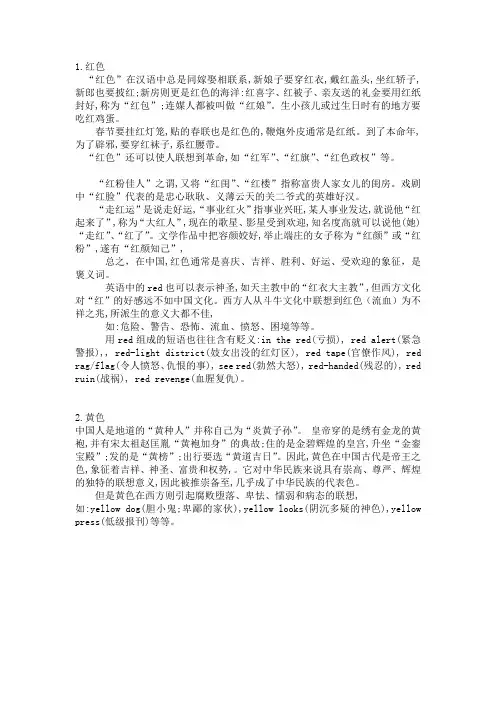
1.红色“红色”在汉语中总是同嫁娶相联系,新娘子要穿红衣,戴红盖头,坐红轿子,新郎也要披红;新房则更是红色的海洋:红喜字、红被子、亲友送的礼金要用红纸封好,称为“红包”;连媒人都被叫做“红娘”。
生小孩儿或过生日时有的地方要吃红鸡蛋。
春节要挂红灯笼,贴的春联也是红色的,鞭炮外皮通常是红纸。
到了本命年,为了辟邪,要穿红袜子,系红腰带。
“红色”还可以使人联想到革命,如“红军”、“红旗”、“红色政权”等。
“红粉佳人”之谓,又将“红闺”、“红楼”指称富贵人家女儿的闺房。
戏剧中“红脸”代表的是忠心耿耿、义薄云天的关二爷式的英雄好汉。
“走红运”是说走好运,“事业红火”指事业兴旺,某人事业发达,就说他“红起来了”,称为“大红人”,现在的歌星、影星受到欢迎,知名度高就可以说他(她)“走红”、“红了”。
文学作品中把容颜姣好,举止端庄的女子称为“红颜”或“红粉”,遂有“红颜知己”,总之,在中国,红色通常是喜庆、吉祥、胜利、好运、受欢迎的象征,是褒义词。
英语中的red也可以表示神圣,如天主教中的“红衣大主教”,但西方文化对“红”的好感远不如中国文化。
西方人从斗牛文化中联想到红色(流血)为不祥之兆,所派生的意义大都不佳,如:危险、警告、恐怖、流血、愤怒、困境等等。
用red组成的短语也往往含有贬义:in the red(亏损), red alert(紧急警报),, red-light district(妓女出没的红灯区), red tape(官僚作风), red rag/flag(令人愤怒、仇恨的事), see red(勃然大怒), red-handed(残忍的), red ruin(战祸), red revenge(血腥复仇)。
2.黄色中国人是地道的“黄种人”并称自己为“炎黄子孙”。
皇帝穿的是绣有金龙的黄袍,并有宋太祖赵匡胤“黄袍加身”的典故;住的是金碧辉煌的皇宫,升坐“金銮宝殿”;发的是“黄榜”;出行要选“黄道吉日”。

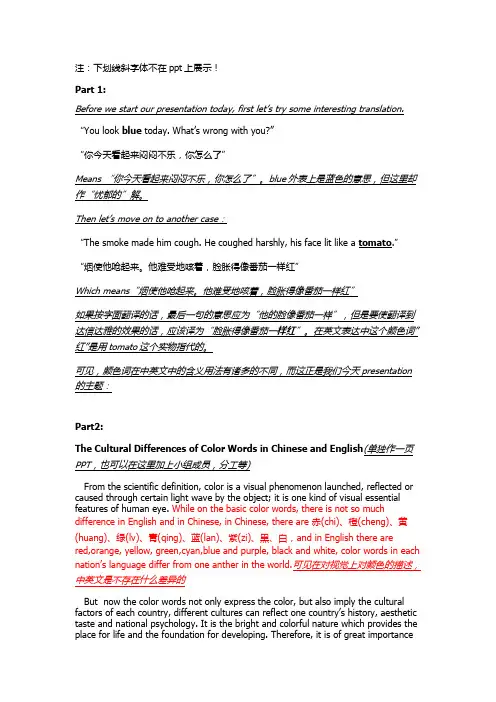
注:下划线斜字体不在ppt上展示!Part 1:Before we start our presentation today, first let’s try some interesting translation. “You look blue today. What’s wrong with you?”“你今天看起来闷闷不乐,你怎么了”Means “你今天看起来闷闷不乐,你怎么了”。
blue外表上是蓝色的意思,但这里却作“忧郁的”解。
Then let’s move on to another case:“The smoke made him cough. He coughed harshly, his face lit like a tomato.”“烟使他呛起来。
他难受地咳着,脸胀得像番茄一样红”Which means“烟使他呛起来。
他难受地咳着,脸胀得像番茄一样红”如果按字面翻译的话,最后一句的意思应为“他的脸像番茄一样”,但是要使翻译到达信达雅的效果的话,应该译为“脸胀得像番茄一样红”。
在英文表达中这个颜色词”红”是用tomato这个实物指代的。
可见,颜色词在中英文中的含义用法有诸多的不同,而这正是我们今天presentation 的主题:Part2:The Cultural Differences of Color Words in Chinese and English(单独作一页PPT,也可以在这里加上小组成员,分工等)From the scientific definition, color is a visual phenomenon launched, reflected or caused through certain light wave by the object; it is one kind of visual essential features of human eye. While on the basic color words, there is not so much difference in English and in Chinese, in Chinese, there are 赤(chi)、橙(cheng)、黄(huang)、绿(lv)、青(qing)、蓝(lan)、紫(zi)、黑、白,and in English there are red,orange, yellow, green,cyan,blue and purple, black and white, color words in each nation’s language differ from one anther in the world.可见在对视觉上对颜色的描述,中英文是不存在什么差异的But now the color words not only express the color, but also imply the cultural factors of each country, different cultures can reflect one country’s history, aesthetic taste and national psychology. It is the bright and colorful nature which provides the place for life and the foundation for developing. Therefore, it is of great importanceto study color words to find out how they reflect cultural differences in both the original and target language and why they can influence our daily life.然而在象征意义和文化含义上,中英文对颜色的理解就十分明显了,并且了解这种差异对于我们学习英语来说是非常有必要的In specific. The main colors of English and Chinese are same or similar,but some color words in one language can refer to more one color in other language. So the English and Chinese color words are not always corresponding word. Take the colorsof red, black, white, yellow, green and blue for examples as showed below.REDBoth in China and English speaking countries, red always be connected with joyous and celebrate events. For example, “red-letter days” in English means memorial day, often refers to Christmas Day. ”to paint the town red” means binge, quaff, or even monkey business〔狂欢痛饮胡闹〕“roll out the red carpet for sb.”〔铺展红地毯隆重地欢送某人〕.red also used to express some sorts of emotion. For instance, “become red-faced”or “sb’s face turned red” has the same meaning with “脸红” in Chinese. And “to see red ” along with “wave a red flag” equals to “为难、发怒” in Chinese.In Chinese particularly, the word “ hong ” represents luck, happiness, success, celebration and festival. In traditional Chinese weddings, not only the decorations are full of red color, including red candle, red quilts, red words “喜”and so on, but also the clothing of the bride and groom, as well as the red veil of the bride〔新娘的红盖头〕, thus bringing a wedding atmosphere and implying the prosperous future of the newlyweds. Furthermore, the word “红火”represents exuberant and lively. The word “红利” , describes the enterprise division of profits to shareholders or bonuses to staff. The word “红颜” refers to a young and beautiful woman.But in English, the word “ red ” represents danger, violence and debauchery〔放纵;沉湎酒色〕 with strong derogatory〔贬义的〕 meaning. When talking about the word red, people always imagine the fire and blood. For instance, “ red-faced ” represents embarrassed or angry; “ red alert ” is a warning that something very dangerous is likely to happen; “ the red rules of tooth and claws ”〔残杀和暴力统治〕means tyranny or a cruel, harsh, and unfair control over other people. With the cultural exchange, the word “ red ” in English comes to have some complimentary sense, such as “ red carpet ” used to welcome very important visitors as the speci al treatment when they arrive. However, in English “ red ” has different meanings in economy, such as “ in the red ” “ get into the red ” both mean somebody is in debt. So “ red ” is really the word making people happy at some time, but upset at other time.No matter in China or western countries, as a darker color, “黑” or “ black ” often has something to do with dirtiness, illegality, death, mourning, sadness, despair, an ger and justice. “V icious”“bad” are common meanings of black in both Chinese and English.In China, “乌黑的手” is what we call dirty hands. “黑市” implies the listed commodities trading allowed without government's approval, “黑车” means the illegal taxi with a higher charge. In the funeral, Chinese will tie a black band around one arm to show the sad feeling. If people get angry, we see the expression “他黑着个脸”. Sometimes “黑” symbolizes the justice, because in ancient China, we had a famous righteous officer called “包拯”, who had black complexion.In western country, “ a black sweet ”“ black water ” mean dirty. “ Black money ” indicates the income earned in an illegal way. Black is also a color for mourning dress (丧服)in Western countries. “ A black dog ” and “ black mood ”both refer to the low spirit of people. When people get angry, they look “ black-browed ” or “ black in the face ” or “ as black as thunder ”, and they also have“ black passion ”.WhiteSimilarities:The color white gives both Chinese and English the similar imagination to some extent. Take “pure” and ”innocent” for example , which means “纯洁,清白无辜的”. In Chinese, the word “白” is the symbol of death, depression and failure. In the funerals, traditional Chinese people always wear white mourning dress to express condolences to the dead. The funeral can also be called “白事” in Chinese. Also, the word “白” has the meaning of the civilian, such as “白丁” represents the illiterate people or the uneducated common people. In traditional drama, the implications of the word “白” is treachery. That is why the famous ancient politician,曹操, was described as “白脸奸臣”.On the contrary, the word “ white ” refers to the chastity, hope, happiness, joy and naivety in English. “ A white lie ” means a lie that you tell someone in order to protect them or avoid hurting their feelings. If someo ne is said to be “ white-handed ”, it means he or she is honest or innocent. In the Bible, the Angels are always with a pair of white wings and a silver-white halo overhead. White is the incarnation〔具象化〕 of being smart, kind and beautiful. the bride always dresses in a white wedding dress as a symbol of pure and beautiful.In ancient China, the word “黄” is a kind of noble color because it signifies the color of the skin of the Chinese people. When it came to “黄”, the majority of Chinese people will be reminded of the yellow clothes which the emperor wore. So, there are a lot of words with “黄”, such as “黄道吉日” with the meaning of the lucky day suitable to do things and “黄袍加身” with the meaning of acclaiming emperor. Nowadays, this word is associated with sex in Chinese. The word “扫黄”is the symbol of the elimination of the pornography and prostitution(淫秽制品以及卖淫嫖娼).As the color of gold and the sun, “ yellow” is the symbol of wealth, honor and power in English. It’s a holy color in Christianity. The Father wears golden crucifix 〔十字架〕, and the holy cup used by Jesus in his last supper is also yellow. In English, there is a phrase “ a yellow ribbon ”, used as a symbol of welcome for those people who will return home. So “ to hang yellow ribbons for somebody ” is to give awarm welcome for one’s return. “ Yellow ” sometimes implies warning. “ A yellow card ” is a card held up by a football referee to show that a player has done something wrong. Later it is used generally throughout the world as a symbol of warning.GreenGreen is a sort of color full of vigor and energy underlying life, youth, hope, peace and energy both in Chinese and English.In Chinese, there is another saying of “绿”, that is “青”, so there exists such phrases as “青春年华”, “常青树”. At present, the color “绿” also means environmental protection, such as in the phrase: “ the Green Party ”, “ Green Revolution ”, “ green food ”, “ green consumerism ” and so forth.But comparatively speaking, green has more associative indications in English such as “ green hands ” and “ be in the green ”, which mean being inexperienced. What’s more, the implications of green can also be envious and jealous, such as “ green with envy ”, “ green as jealousy ” and “ green-eyed monster ”. In Britain as well as in the United States, the color green is one of the favorite colors, and there are many places decorated with green color and even US dollars are green. Thus the color term “ green ” is often used to refer to money or fortune.BlueIn Chinese, the word “ 蓝” represents the color of the sky and water, symbolizing calm, reflection, modesty and the intellect. In fact, the implications of Chinese word“ 蓝” is less. To Chinese people, blue is the color of the dress worn by Confucian scholars in ancient times, and “蓝衫”was once used to refer to “秀才”, who passed the imperial examination at the county level in Ming and Qing dynasties.In English, the word “ blue ” commonly is a metaphor of depression, frustration, sorrow and anguish. If somebody is “ in a blue mood ”, he or sh e may feel sad, gloomy and depressed. Similar in meaning is “ a blue Monday ”, indicating the first day of work or school after a pleasant, happy weekend. Moreover, blue denotes high social position or being aristocratic〔贵族的〕. For instance, “ blue-blooded ” describes someone who have been born into a family which belongs to a royal or noble family or the highest social class. In contrast, another meaning of “ blue ” in English is connected with sex. “ Blue movie ” means a movie showing a lot of sexual activ ity, and “ blue talk ” means a talk which is coarse〔粗俗的〕.Part3:The Reasons for Different Culture Connotation between English and Chinese Color Words1、Natural EnvironmentsWe know the weather of England is always warm and the wool spinning industry has developed rapidly in England from early time.Thereby,English people often use sheep or wool as analogue. For example,there is wool so white but a dyer call make it black(羊毛虽白,染之则黑)As rice is the main food in china, Chinese is accustomed to using “米黄色” to describe the yellow just like the color of rice, while in western countries, butter and cream is the daily food, so “cream ” or “ butter- yellow” is often used in English. But in English yellow also has meanings of vulgar and despicable which has nothing to do with pornographic as yellow means in Chinese. This kind of usage began in 1895.New York world published picture story caricature yellow kids that was printed in yellow.Yellow journalisms and yellow covered literatures are just some vulgar publications.2、Historical BackgroundsIn Chinese, “绿帽子” (lv mao zi) is a metaphor, which means to be a cuckold. This kind of usage appropriately began in Tang dynasty. At that time, the male in brothel should wear a green hat to represent their identity. Chinese ancients viewed green as an impure color and represents low class. Therefore, the one whose wife has a paramour is called “戴绿帽子”. While western countries have no similar historic background, they don’t understand the meaning inside. In translation, it can not be simply translated into “He wears a green hat”, but “a cuckold husband”。
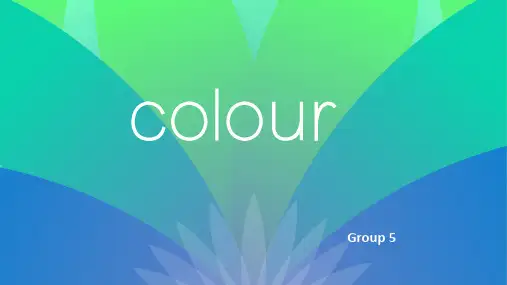
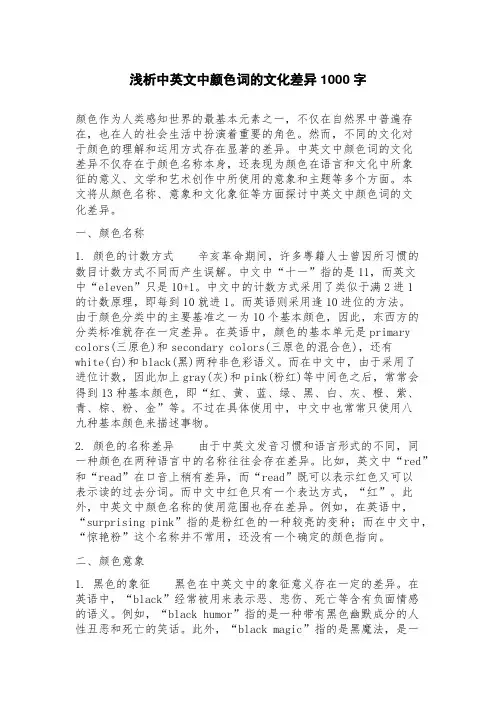
浅析中英文中颜色词的文化差异1000字颜色作为人类感知世界的最基本元素之一,不仅在自然界中普遍存在,也在人的社会生活中扮演着重要的角色。
然而,不同的文化对于颜色的理解和运用方式存在显著的差异。
中英文中颜色词的文化差异不仅存在于颜色名称本身,还表现为颜色在语言和文化中所象征的意义、文学和艺术创作中所使用的意象和主题等多个方面。
本文将从颜色名称、意象和文化象征等方面探讨中英文中颜色词的文化差异。
一、颜色名称1. 颜色的计数方式辛亥革命期间,许多粤籍人士曾因所习惯的数目计数方式不同而产生误解。
中文中“十一”指的是11,而英文中“eleven”只是10+1。
中文中的计数方式采用了类似于满2进1的计数原理,即每到10就进1。
而英语则采用逢10进位的方法。
由于颜色分类中的主要基准之一为10个基本颜色,因此,东西方的分类标准就存在一定差异。
在英语中,颜色的基本单元是primary colors(三原色)和secondary colors(三原色的混合色),还有white(白)和black(黑)两种非色彩语义。
而在中文中,由于采用了进位计数,因此加上gray(灰)和pink(粉红)等中间色之后,常常会得到13种基本颜色,即“红、黄、蓝、绿、黑、白、灰、橙、紫、青、棕、粉、金”等。
不过在具体使用中,中文中也常常只使用八九种基本颜色来描述事物。
2. 颜色的名称差异由于中英文发音习惯和语言形式的不同,同一种颜色在两种语言中的名称往往会存在差异。
比如,英文中“red”和“read”在口音上稍有差异,而“read”既可以表示红色又可以表示读的过去分词。
而中文中红色只有一个表达方式,“红”。
此外,中英文中颜色名称的使用范围也存在差异。
例如,在英语中,“surprising pink”指的是粉红色的一种较亮的变种;而在中文中,“惊艳粉”这个名称并不常用,还没有一个确定的颜色指向。
二、颜色意象1. 黑色的象征黑色在中英文中的象征意义存在一定的差异。
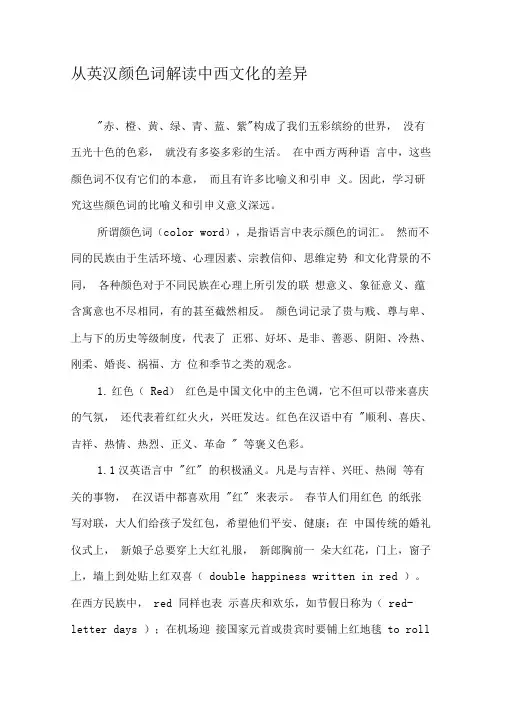
从英汉颜色词解读中西文化的差异"赤、橙、黄、绿、青、蓝、紫"构成了我们五彩缤纷的世界,没有五光十色的色彩,就没有多姿多彩的生活。
在中西方两种语言中,这些颜色词不仅有它们的本意,而且有许多比喻义和引申义。
因此,学习研究这些颜色词的比喻义和引申义意义深远。
所谓颜色词(color word),是指语言中表示颜色的词汇。
然而不同的民族由于生活环境、心理因素、宗教信仰、思维定势和文化背景的不同,各种颜色对于不同民族在心理上所引发的联想意义、象征意义、蕴含寓意也不尽相同,有的甚至截然相反。
颜色词记录了贵与贱、尊与卑、上与下的历史等级制度,代表了正邪、好坏、是非、善恶、阴阳、冷热、刚柔、婚丧、祸福、方位和季节之类的观念。
1.红色(Red)红色是中国文化中的主色调,它不但可以带来喜庆的气氛,还代表着红红火火,兴旺发达。
红色在汉语中有"顺利、喜庆、吉祥、热情、热烈、正义、革命" 等褒义色彩。
1.1汉英语言中"红" 的积极涵义。
凡是与吉祥、兴旺、热闹等有关的事物,在汉语中都喜欢用"红" 来表示。
春节人们用红色的纸张写对联,大人们给孩子发红包,希望他们平安、健康;在中国传统的婚礼仪式上,新娘子总要穿上大红礼服,新郎胸前一朵大红花,门上,窗子上,墙上到处贴上红双喜(double happiness written in red )。
在西方民族中,red 同样也表示喜庆和欢乐,如节假日称为(red-letter days );在机场迎接国家元首或贵宾时要铺上红地毯to rollout the red carpet for someone ,以示隆重热烈的欢迎。
1.2汉语言中" 红" 的革命含义。
中国革命的成功又给红色增加了政治涵义。
如:红旗、红色根据地等。
中国共产党最初的政权叫"红色政权" ;最早的武装叫"红军" 。

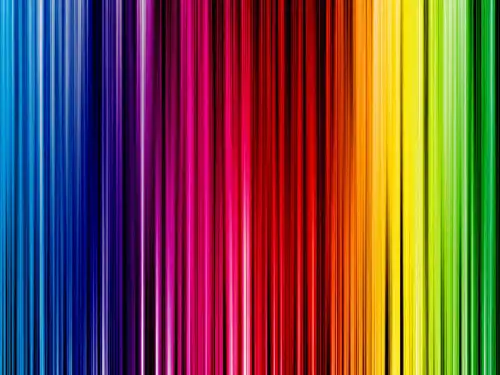
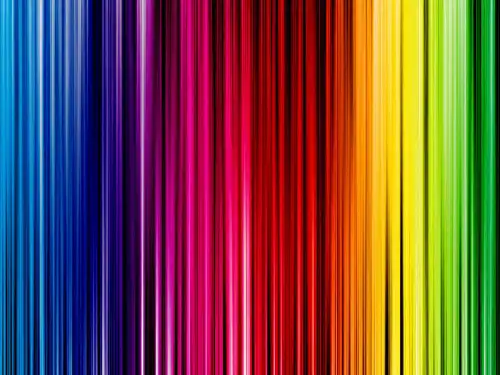
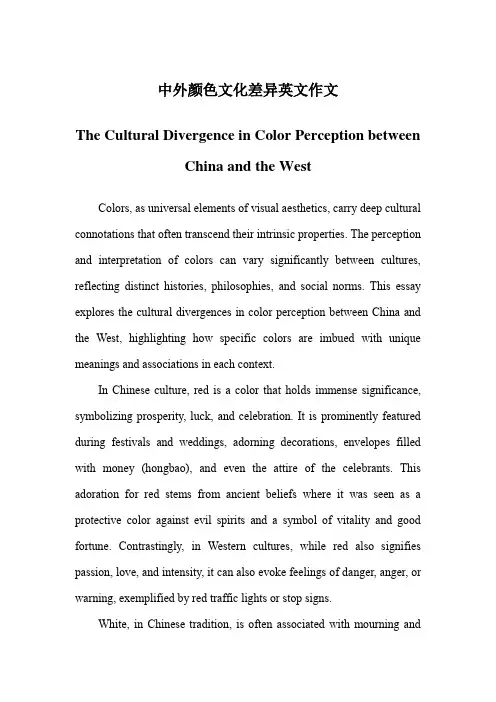
中外颜色文化差异英文作文The Cultural Divergence in Color Perception betweenChina and the WestColors, as universal elements of visual aesthetics, carry deep cultural connotations that often transcend their intrinsic properties. The perception and interpretation of colors can vary significantly between cultures, reflecting distinct histories, philosophies, and social norms. This essay explores the cultural divergences in color perception between China and the West, highlighting how specific colors are imbued with unique meanings and associations in each context.In Chinese culture, red is a color that holds immense significance, symbolizing prosperity, luck, and celebration. It is prominently featured during festivals and weddings, adorning decorations, envelopes filled with money (hongbao), and even the attire of the celebrants. This adoration for red stems from ancient beliefs where it was seen as a protective color against evil spirits and a symbol of vitality and good fortune. Contrastingly, in Western cultures, while red also signifies passion, love, and intensity, it can also evoke feelings of danger, anger, or warning, exemplified by red traffic lights or stop signs.White, in Chinese tradition, is often associated with mourning anddeath, as it is the color worn during funeral rites. This association stems from ancient times when white was the color of the underworld and was believed to represent purity in the afterlife. Conversely, in Western cultures, white is synonymous with purity, innocence, and new beginnings, commonly seen in wedding dresses and christening ceremonies.Yellow, a color of imperial significance in ancient China, represents nobility, honor, and sometimes, happiness. The Forbidden City, the imperial palace of China, features extensive use of yellow in its architecture, symbolizing the emperor's supreme power. In contrast, Western cultures often associate yellow with joy, sunshine, and energy, but it can also carry connotations of cowardice or caution, as evidenced by the term "yellow-bellied."Green, in Chinese culture, is linked to youth, growth, and vitality, mirroring its natural associations with plants and spring. However, it can also have negative connotations, such as being inexperienced or jealous. In Western societies, green similarly represents renewal and nature but is also strongly tied to wealth, finance (e.g., the "greenback" for American currency), and environmentalism. Its negative associations include envy or being ill (e.g., "green with envy" or "feeling green").Lastly, black in Chinese culture is traditionally associated with darkness, evil, and misfortune, seldom used in celebratory contexts. InWestern cultures, while black can indeed signify mourning or solemnity, it is also a symbol of elegance, sophistication, and authority, commonly seen in formal attire or luxury branding.These divergences underscore how color perception is deeply embedded within cultural narratives, influencing art, fashion, rituals, and daily life. Understanding these differences fosters cross-cultural empathy and appreciation, enabling more effective communication and collaboration in our increasingly interconnected world. As we navigate diverse cultural landscapes, recognizing the unique stories each color tells within its respective context becomes a valuable tool in bridging understanding and respect.。
从颜色词看中英文化差异
中国文化对颜色有着独特的理解和赋予,与英文文化存在一些差异。
下面是一些常见颜色词在中英文化中的差异:
1. 红色 (Red):在中国文化中,红色代表着喜庆、热情、吉祥和好运。
红色是中国文化中最喜欢的颜色,常用于喜庆的场合,如婚礼和春节。
而在英文文化中,红色通常与爱情、激情和力量相关。
2. 黄色 (Yellow):在中国文化中,黄色象征着皇权和尊贵。
中国古
代帝王常使用黄色作为皇家颜色。
黄色还象征着丰收和土地的肥沃。
而在
英文文化中,黄色通常与太阳、温暖、快乐和活力相关。
3. 白色 (White):在中国文化中,白色代表着清白、纯洁和丧事悼念。
白色常用于婚礼中新娘的婚纱以及葬礼上的丧服。
而在英文文化中,
白色通常与纯洁和无暇相关。
4. 蓝色 (Blue):在中国文化中,蓝色常与男性相关,代表着清澈和
纯净。
而在英文文化中,蓝色通常与忧郁和冷静相关,例如“Monday blues”表示星期一的低落情绪。
5. 绿色 (Green):在中国文化中,绿色与春天、生命和希望相关,
被视为吉祥的颜色。
而在英文文化中,绿色通常与自然、环保和生态相关,也与嫉妒相关(green with envy)。
这些是一些常见颜色词在中英文化中的差异。
颜色的文化赋予不仅体
现了不同的情绪和象征意义,也反映了不同文化对生活和世界的认知和态度。
红色是我国文化中的基本崇尚色,它体现了中国人在精神和物质上的追求。
它象征着吉祥、喜庆,如把促成他人美好婚姻的人叫"红娘",喜庆日子要挂大红灯笼、贴红对联、红福字;男娶女嫁时贴大红"喜"字,把热闹、兴旺叫做" 红火";形容繁华、热闹的地方叫"红尘";它又象征革命和进步,如中共最初的政权叫“红色政权”,最早的武装叫“红军”,把政治上要求进步、业务上刻苦钻研的人称为“又红又专”等;它也象征顺利、成功,如人的境遇很好被称为"走红"、"红极一时",得到上司宠信的叫"红人",分到合伙经营利润叫"分红",给人发奖金叫"送红包"等;它还象征美丽、漂亮,如指女子盛妆为"红妆"或"红装",把艳妆女子称为"红袖",指女子美艳的容颜为"红颜"等。
西方文化中的红色(red)则是一个贬意相当强的词,是"火"、"血"的联想,它象征着残暴、流血,如(1)Theredrulesoftoothandclaw 残杀和暴力统治,(2)redrevenge 血腥复仇,(3)aredbattle 血战;它又象征激进、暴力革命,如(1)red hot political campaign 激烈的政治运动,(2)a red revolution 赤色革命,(3)red activities 左派激进活动;它也象征危险、紧张,如(1)red alert 空袭报警,(2)a red adventure story 一个令人紧张的冒险故事,(3)a red flag 危险信号旗;它还象征着放荡、淫秽,如(1)a red waste of his youth 他那因放荡而浪费的青春,(2)a red light district 花街柳巷(红灯区),(3) Is she really sored as she is painted难到她真的象人们所描绘的那样放荡吗?至于红色的褒义,如red—letterday 喜庆的日子,theredcarpet 隆重的接待等,则得益于不同文化之间的交流和融合。
注:下划线斜字体不在ppt上展示!Part 1:Before we start our presentation today, first let’s try some interesting translation. “You look blue today. What’s wrong with you?”“你今天看起来闷闷不乐,你怎么了”Means “你今天看起来闷闷不乐,你怎么了”。
blue表面上是蓝色的意思,但这里却作“忧郁的”解。
Then let’s move on to another case:“The smoke made him cough. He coughed harshly, his face lit like a tomato.”“烟使他呛起来。
他难受地咳着,脸胀得像番茄一样红”Which means“烟使他呛起来。
他难受地咳着,脸胀得像番茄一样红”如果按字面翻译的话,最后一句的意思应为“他的脸像番茄一样”,但是要使翻译达到信达雅的效果的话,应该译为“脸胀得像番茄一样红”。
在英文表达中这个颜色词”红”是用tomato这个实物指代的。
可见,颜色词在中英文中的含义用法有诸多的不同,而这正是我们今天presentation 的主题:Part2:The Cultural Differences of Color Words in Chinese and English(单独作一页PPT,也可以在这里加上小组成员,分工等)From the scientific definition, color is a visual phenomenon launched, reflected or caused through certain light wave by the object; it is one kind of visual essential features of human eye. While on the basic color words, there is not so much difference in English and in Chinese, in Chinese, there are 赤(chi)、橙(cheng)、黄(huang)、绿(lv)、青(qing)、蓝(lan)、紫(zi)、黑、白,and in English there are red,orange, yellow, green,cyan,blue and purple, black and white, color words in each nation’s language differ from one anther in the world.可见在对视觉上对颜色的描述,中英文是不存在什么差异的But now the color words not only express the color, but also imply the cultural factors of each country, different cultures can reflect one country’s history, aesthetic taste and national psychology. It is the bright and colorful nature which provides the place for life and the foundation for developing. Therefore, it is of great importanceto study color words to find out how they reflect cultural differences in both the original and target language and why they can influence our daily life.然而在象征意义和文化含义上,中英文对颜色的理解就十分明显了,并且了解这种差异对于我们学习英语来说是非常有必要的In specific. The main colors of English and Chinese are same or similar,but some color words in one language can refer to more one color in other language. So the English and Chinese color words are not always corresponding word. Take the colorsof red, black, white, yellow, green and blue for examples as showed below.REDBoth in China and English speaking countries, red always be connected with joyous and celebrate events. For example, “red-letter days” in English means memorial day, often refers to Christmas Day. ”to paint the town red” means binge, quaff, or even monkey business(狂欢痛饮胡闹)“roll out the red carpet for sb.”(铺展红地毯隆重地欢迎某人).red also used to express some sorts of emotion. For instance, “become red-faced”or “sb’s face turned red” has the same meaning with “脸红” in Chinese. And “to see red ” along with “wave a red flag” equals to “为难、发怒” in Chinese.In Chinese particularly, the word “ hong ” represents luck, happiness, success, celebration and festival. In traditional Chinese weddings, not only the decorations are full of red color, including red candle, red quilts, red words “喜”and so on, but also the clothing of the bride and groom, as well as the red veil of the bride(新娘的红盖头), thus bringing a wedding atmosphere and implying the prosperous future of the newlyweds. Furthermore, the word “红火”represents exuberant and lively. The word “红利” , describes the enterprise division of profits to shareholders or bonuses to staff. The word “红颜” refers to a young and beautiful woman.But in English, the word “ red ” represents danger, violence and debauchery(放荡;沉湎酒色) with strong derogatory(贬义的) meaning. When talking about the word red, people always imagine the fire and blood. For instance, “ red-faced ” represents embarrassed or angry; “ red alert ” is a warning that something very dangerous is likely to happen; “ the red rules of tooth and claws ”(残杀和暴力统治)means tyranny or a cruel, harsh, and unfair control over other people. With the cultural exchange, the word “ red ” in English comes to have some complimentary sense, such as “ red carpet ” used to welcome very important visitors as the speci al treatment when they arrive. However, in English “ red ” has different meanings in economy, such as “ in the red ” “ get into the red ” both mean somebody is in debt. So “ red ” is really the word making people happy at some time, but upset at other time.No matter in China or western countries, as a darker color, “黑” or “ black ” often has something to do with dirtiness, illegality, death, mourning, sadness, despair, an ger and justice. “V icious”“bad” are common meanings of black in both Chinese and English.In China, “乌黑的手” is what we call dirty hands. “黑市” implies the listed commodities trading allowed without government's approval, “黑车” means the illegal taxi with a higher charge. In the funeral, Chinese will tie a black band around one arm to show the sad feeling. If people get angry, we see the expression “他黑着个脸”. Sometimes “黑” symbolizes the justice, because in ancient China, we had a famous righteous officer called “包拯”, who had black complexion.In western country, “ a black sweet ”“ black water ” mean dirty. “ Black money ” indicates the income earned in an illegal way. Black is also a color for mourning dress (丧服)in Western countries. “ A black dog ” and “ black mood ”both refer to the low spirit of people. When people get angry, they look “ black-browed ” or “ black in the face ” or “ as black as thunder ”, and they also have“ black passion ”.WhiteSimilarities:The color white gives both Chinese and English the similar imagination to some extent. Take “pure” and ”innocent” for example , which means “纯洁,清白无辜的”. In Chinese, the word “白” is the symbol of death, depression and failure. In the funerals, traditional Chinese people always wear white mourning dress to express condolences to the dead. The funeral can also be called “白事” in Chinese. Also, the word “白” has the meaning of the civilian, such as “白丁” represents the illiterate people or the uneducated common people. In traditional drama, the implications of the word “白” is treachery. That is why the famous ancient politician,曹操, was described as “白脸奸臣”.On the contrary, the word “ white ” refers to the chastity, hope, happiness, joy and naivety in English. “ A white lie ” means a lie that you tell someone in order to protect them or avoid hurting their feelings. If s omeone is said to be “ white-handed ”, it means he or she is honest or innocent. In the Bible, the Angels are always with a pair of white wings and a silver-white halo overhead. White is the incarnation(具象化) of being smart, kind and beautiful. the bride always dresses in a white wedding dress as a symbol of pure and beautiful.In ancient China, the word “黄” is a kind of noble color because it signifies the color of the skin of the Chinese people. When it came to “黄”, the majority of Chinese people will be reminded of the yellow clothes which the emperor wore. So, there are a lot of words with “黄”, such as “黄道吉日” with the meaning of the lucky day suitable to do things and “黄袍加身” with the meaning of acclaiming emperor. Nowadays, this word is associated with sex in Chinese. The word “扫黄”is the symbol of the elimination of the pornography and prostitution(淫秽制品以及卖淫嫖娼).As the color of gold and the sun, “ yellow ” is the symbol of wealth, honor and power in English. It’s a holy color in Christianity. The Father wears golden crucifix (十字架), and the holy cup used by Jesus in his last supper is also yellow. In English, there is a phrase “ a yellow ribbon ”, used as a symbol of welcome for those people who will return home. So “ to hang yellow ribbons for somebody ” is to give awarm welcome for one’s return. “ Yellow ” sometimes implies warning. “ A yellow card ” is a card held up by a football referee to show that a player has done something wrong. Later it is used generally throughout the world as a symbol of warning.GreenGreen is a sort of color full of vigor and energy underlying life, youth, hope, peace and energy both in Chinese and English.In Chinese, there is another saying of “绿”, that is “青”, so there exists such phrases as “青春年华”, “常青树”. At present, the color “绿” also means environmental protection, such as in the phrase: “ the Green Party ”, “ Green Revolution ”, “ green food ”, “ green consumerism ” and so forth.But comparatively speaking, green has more associative indications in English such as “ green hands ” and “ be in the green ”, which mean being inexperienced. What’s more, the implications of green can also be envious and jealous, such as “ green with envy ”, “ green as jealousy ” and “ green-eyed monster ”. In Britain as well as in the United States, the color green is one of the favorite colors, and there are many places decorated with green color and even US dollars are green. Thus the color term “ green ” is often used to refer to money or fortune.BlueIn Chinese, th e word “ 蓝” represents the color of the sky and water, symbolizing calm, reflection, modesty and the intellect. In fact, the implications of Chinese word“ 蓝” is less. To Chinese people, blue is the color of the dress worn by Confucian scholars in ancient times, and “蓝衫”was once used to refer to “秀才”, who passed the imperial examination at the county level in Ming and Qing dynasties.In English, the word “ blue ” commonly is a metaphor of depression, frustration, sorrow and anguish. If somebody is “ in a blue mood ”, he or she may feel sad, gloomy and depressed. Similar in meaning is “ a blue Monday ”, indicating the first day of work or school after a pleasant, happy weekend. Moreover, blue denotes high social position or being aristocratic(贵族的). For i nstance, “ blue-blooded ” describes someone who have been born into a family which belongs to a royal or noble family or the highest social class. In contrast, another meaning of “ blue ” in English is connected with sex. “ Blue movie ” means a movie showi ng a lot of sexual activity, and “ blue talk ” means a talk which is coarse(粗俗的).Part3:The Reasons for Different Culture Connotation between English and Chinese Color Words1、Natural EnvironmentsWe know the weather of England is always warm and the wool spinning industry has developed rapidly in England from early time.Thereby,English people often use sheep or wool as analogue. For example,there is wool so white but a dyer call make it black(羊毛虽白,染之则黑)As rice is the main food in china, Chinese is accustomed to using “米黄色” to describe the yellow just like the color of rice, while in western countries, butter and cream is the daily food, so “cream ” or “ butter- yellow” is often used in English. But in English yellow also has meanings of vulgar and despicable which has nothing to do with pornographic as yellow means in Chinese. This kind of usage began in 1895.New York world published picture story caricature yellow kids that was printed in yellow.Yellow journalisms and yellow covered literatures are just some vulgar publications.2、Historical BackgroundsIn Chinese, “绿帽子” (lv mao zi) is a metaphor, which means to be a cuckold. This kind of usage appropriately began in Tang dynasty. At that time, the male in brothel should wear a green hat to represent their identity. Chinese ancients viewed green as an impure color and represents low class. Therefore, the one whose wife has a paramour is called “戴绿帽子”. While western countries have no similar historic background, they don’t understand the meaning inside. In translation, it can not be simply translated into “He wears a green hat”, but “a cuckold husband”。